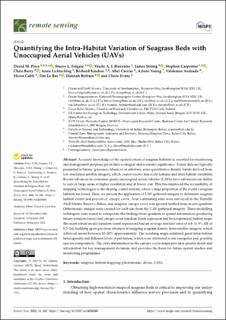| dc.contributor.author | Price, David M. | |
| dc.contributor.author | Felgate, Stacey L. | |
| dc.contributor.author | Huvenne, Veerle A. I. | |
| dc.contributor.author | Strong, James | |
| dc.contributor.author | Carpenter, Stephen | |
| dc.contributor.author | Barry, Chris | |
| dc.contributor.author | Lichtschlag, Anna | |
| dc.contributor.author | Sanders, Richard | |
| dc.contributor.author | Carrias, Abel | |
| dc.contributor.author | Young, Arlene | |
| dc.contributor.author | Andrade, Valdemar | |
| dc.contributor.author | Cobb, Eliceo | |
| dc.contributor.author | Le Bas, Tim | |
| dc.contributor.author | Brittain, Hannah | |
| dc.contributor.author | Evans, Claire | |
| dc.date.accessioned | 2023-09-20T07:26:15Z | |
| dc.date.available | 2023-09-20T07:26:15Z | |
| dc.date.created | 2022-11-30T09:11:54Z | |
| dc.date.issued | 2022 | |
| dc.identifier.citation | Remote Sensing. 2022, 14 (3), . | en_US |
| dc.identifier.issn | 2072-4292 | |
| dc.identifier.uri | https://hdl.handle.net/11250/3090651 | |
| dc.description.abstract | Accurate knowledge of the spatial extent of seagrass habitats is essential for monitoring and management purposes given their ecological and economic significance. Extent data are typically presented in binary (presence/absence) or arbitrary, semi-quantitative density bands derived from low-resolution satellite imagery, which cannot resolve fine-scale features and intra-habitat variability. Recent advances in consumer-grade unoccupied aerial vehicles (UAVs) have advanced our ability to survey large areas at higher resolution and at lower cost. This has improved the accessibility of mapping technologies to developing coastal nations, where a large proportion of the world’s seagrass habitats are found. Here, we present the application of UAV-gathered imagery to determine seagrass habitat extent and percent of canopy cover. Four contrasting sites were surveyed in the Turneffe Atoll Marine Reserve, Belize, and seagrass canopy cover was ground truthed from in situ quadrats. Orthomosaic images were created for each site from the UAV-gathered imagery. Three modelling techniques were tested to extrapolate the findings from quadrats to spatial information, producing binary (random forest) and canopy cover (random forest regression and beta regression) habitat maps. The most robust model (random forest regression) had an average absolute error of 6.8–11.9% (SE of 8.2–14), building upon previous attempts at mapping seagrass density from satellite imagery, which achieved errors between 15–20% approximately. The resulting maps exhibited great intra-habitat heterogeneity and different levels of patchiness, which were attributed to site energetics and, possibly, species composition. The extra information in the canopy cover maps provides greater detail and information for key management decisions and provides the basis for future spatial studies and monitoring programmes. | en_US |
| dc.language.iso | eng | en_US |
| dc.rights | Navngivelse 4.0 Internasjonal | * |
| dc.rights.uri | http://creativecommons.org/licenses/by/4.0/deed.no | * |
| dc.title | Quantifying the Intra-Habitat Variation of Seagrass Beds with Unoccupied Aerial Vehicles (UAVs) | en_US |
| dc.title.alternative | Quantifying the Intra-Habitat Variation of Seagrass Beds with Unoccupied Aerial Vehicles (UAVs) | en_US |
| dc.type | Peer reviewed | en_US |
| dc.type | Journal article | en_US |
| dc.rights.holder | © 2022 by the authors. | en_US |
| dc.description.version | publishedVersion | en_US |
| cristin.ispublished | true | |
| cristin.fulltext | original | |
| cristin.qualitycode | 1 | |
| dc.identifier.doi | 10.3390/rs14030480 | |
| dc.identifier.cristin | 2084997 | |
| dc.source.journal | Remote Sensing | en_US |
| dc.source.volume | 14 | en_US |
| dc.source.issue | 3 | en_US |
| dc.source.pagenumber | 19 | en_US |

